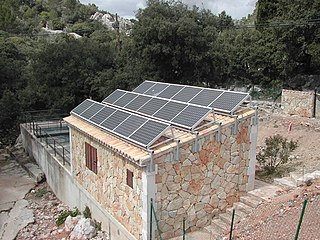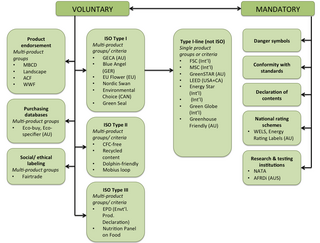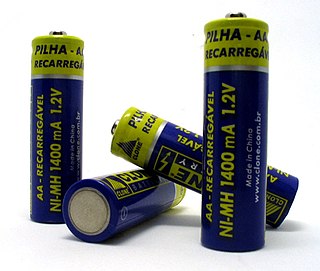ISO 14000 is a family of standards by the International Organization for Standardization (ISO) related to environmental management that exists to help organizations (a) minimize how their operations negatively affect the environment ; (b) comply with applicable laws, regulations, and other environmentally oriented requirements; and (c) continually improve in the above.

Environment friendly processes, or environmental-friendly processes, are sustainability and marketing terms referring to goods and services, laws, guidelines and policies that claim reduced, minimal, or no harm upon ecosystems or the environment.

Ecolabels and Green Stickers are labeling systems for food and consumer products. The use of ecolabels is voluntary, whereas green stickers are mandated by law; for example, in North America major appliances and automobiles use Energy Star. They are a form of sustainability measurement directed at consumers, intended to make it easy to take environmental concerns into account when shopping. Some labels quantify pollution or energy consumption by way of index scores or units of measurement, while others assert compliance with a set of practices or minimum requirements for sustainability or reduction of harm to the environment. Many ecolabels are focused on minimising the negative ecological impacts of primary production or resource extraction in a given sector or commodity through a set of good practices that are captured in a sustainability standard. Through a verification process, usually referred to as "certification", a farm, forest, fishery, or mine can show that it complies with a standard and earn the right to sell its products as certified through the supply chain, often resulting in a consumer-facing ecolabel.
Sustainability reporting refers to the disclosure, whether voluntary, solicited, or required, of non-financial performance information to outsiders of the organization. Sustainability reporting deals with qualitative and quantitative information concerning environmental, social, economic and governance issues. These are the criteria often gathered under the acronym ESG.

Product certification or product qualification is the process of certifying that a certain product has passed performance tests and quality assurance tests, and meets qualification criteria stipulated in contracts, regulations, or specifications.
An environmental management system (EMS) is "a system which integrates policy, procedures and processes for training of personnel, monitoring, summarizing, and reporting of specialized environmental performance information to internal and external stakeholders of a firm".
Various energy conservation measures are taken in the United Kingdom.
Environment, health and safety is an interdisciplinary field focused on the study and implementation of practical aspects environmental protection and safeguard of people's health and safety, especially at company level and in an occupational context. It is what organizations must do to make sure that their activities do not cause harm. Commonly, quality - quality assurance and quality control - is adjoined to form a company division referred to as HSQE or equivalent initialisms.

The Directive 2006/66/EC of the European Parliament and of the Council of 6 September 2006 on batteries and accumulators and waste batteries and accumulators and repealing Directive 91/157/EEC, commonly known as the Battery Directive, regulates the manufacture and disposal of batteries in the European Union with the aim of "improving the environmental performance of batteries and accumulators".

The British Standards Institution (BSI) is the national standards body of the United Kingdom. BSI produces technical standards on a wide range of products and services and also supplies certification and standards-related services to businesses.
An environmental audit is a type of evaluation intended to identify environmental compliance and management system implementation gaps, along with related corrective actions. In this way they perform an analogous (similar) function to financial audits. There are generally two different types of environmental audits: compliance audits and management systems audits. Compliance audits tend to be the primary type in the US or within US-based multinationals.
The End of Life Vehicles Directive is a Directive of the European Union addressing the end of life for automotive products. Every year, motor vehicles which have reached the end of their useful lives create between 8 and 9 million tonnes of waste in the European Union. In 1997, the European Commission adopted a Proposal for a Directive to tackle this problem.
Small and Medium Enterprises (SMEs) are defined by the European Commission as having less than 250 employees, independent and with an annual turnover of no more than €50 million or annual balance sheet of €43 million.
Sustainable products are products who are either sustainability sourced, manufactured or processed that provide environmental, social and economic benefits while protecting public health and environment over their whole life cycle, from the extraction of raw materials until the final disposal.
ISO 50001Energy management systems - Requirements with guidance for use, is an international standard created by the International Organization for Standardization (ISO). It supports organizations in all sectors to use energy more efficiently through the development of an energy Management System. The standard specifies the requirements for establishing, implementing, maintaining and improving an energy management system, whose purpose is to enable an organization to follow a systematic approach in achieving continual improvement of energy performance, including energy efficiency, energy security, energy use and consumption.
Environmental certification is a form of environmental regulation and development where a company can voluntarily choose to comply with predefined processes or objectives set forth by the certification service. Most certification services have a logo which can be applied to products certified under their standards. This is seen as a form of corporate social responsibility allowing companies to address their obligation to minimise the harmful impacts to the environment by voluntarily following a set of externally set and measured objectives.
Energy brokers assist clients in procuring electric or natural gas from energy wholesalers/suppliers. Since electricity and natural gas are commodities, prices change daily with the market. It is challenging for most businesses without energy managers to obtain price comparisons from a variety of suppliers since prices must be compared on exactly the same day. In addition, the terms of the particular contract offered by the supplier influences the price that is quoted. An energy broker can provide a valuable service if they work with a large number of suppliers and can actually compile the sundry prices from suppliers. An important aspect of this consulting role is to assure that the client understands the differences between the contract offers. Under some State Laws they use the term "Suppliers" to refer to energy suppliers, brokers, and aggregators, however there are very important differences between them all.
Social accounting is the process of communicating the social and environmental effects of organizations' economic actions to particular interest groups within society and to society at large. Social Accounting is different from public interest accounting as well as from critical accounting.
Eco-Lighthouse is a Norwegian environmental management certification scheme, operated by the Eco-Lighthouse Foundation in Kristiansand. About 7700 Norwegian private and public organisations are certified, mostly SMEs. The objective is to achieve and document continuous improvement using the Plan-Do-Check-Act-cycle. Since 2017, the Eco-Lighthouse scheme is recognized by the EU to be equivalent to EMAS and ISO 14001 in public procurement.

Christine Maria Jasch is an Austrian economist, author and accountant.







